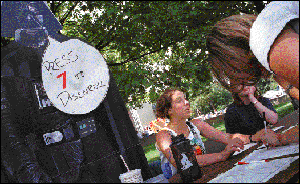
This web page is part of the Michigan Today Archive. To see this story in its original context, click here. |
||||
Talking About Words: A CRISP
acronym
|
||||
 |
| In September 1997, students petitioned to have alumnus James Earl Jones “become the official voice” of the University’s CRISP registration telephone line. The unsuccessful effort was mounted by The James Earl Jones (JEJ) For CRISP Lady Task Force. |
How do I CRISP?
This arresting question appears in a dialogue created under the heading FAQ at a University of Michigan Web site. Like ‘Diag,’ ‘CRISP’ is one of those words that lets alumni of a certain era know they went to school in Ann Arbor. Diag has been around for a long time—it describes the greensward on Central Campus with its corner-to-corner diagonal sidewalk. CRISP came all of a sudden, but it is now slowly vanishing from the usage of undergraduates.
Students who were here in the last 30 years of the last century all knew this expression, though not all of them knew where it came from. It is a word formed from the initial letters of ‘Computerized Registration Involving Student Participation.’
If you have a hunch that CRISP came first and the awkward phrase second, you are right. In fact, the system was developed in a computer science class (CCS 673) taught by Prof. Bernard Galler in 1970.
Its creators first called it ‘Computer Registration in Spite of Problems,’ but the Data Systems Center people didn’t like that name. So they kept CRISP and thought up new words for the letters to represent. (Exactly the same thing happened just a few years after when some hobbyists developed what was called QDOS for ‘quick and dirty operating system.’ Microsoft stripped off the Q and improved the underlying words to ‘disk operating system’ and so launched one of the greatest corporate successes of all time.)
A string of initial letters pronounced as a word is an acronym, a term first appearing in print in 1943. This way of forming words has been around somewhat longer, but not much.
The first expressions we know to be acronyms spring up in the 1890s, though it’s hard to know from the evidence of print just how people said things. (For instance, how would one know from the words alone that U.N. is pronounced to rhyme with ‘do then’ rather than ‘fun’? It is not obvious that we should say ‘eff ay cue’ for FAQ ‘frequently asked questions’ instead of ‘fack’.)
There are lots of acronyms around, and we like the ones that have some wit in them: SNAFU ‘situation normal, all f***ed up,’ WAC ‘women’s army corps’ (from World War II military slang), FIFO ‘first in first out’ (from 1940s accountants) and WISYWYG ‘what you see is what you get’ (from 1980s computer jockeys).
The campus—like the English language—abounds in acronyms, and knowing how to say them (and what they mean) is part of our U-M family language.
There’s an afterlife to these things, too. The Shapiro Library hasn’t quite shaken off the acronym, the UGLI (Undergraduate Library). And students still CRISP when they use the on-line registration system.
Richard W. Bailey is the Fred Newton Scott Collegiate
Professor of English. His most recent book is Rogue Scholar: The
Sinister Life and Celebrated Death of Edward H. Rulloff, University
of Michigan Press, 2003 (see http://www.press.umich.edu/titles/11337.html)
|
Michigan
Today News-e is a new, monthly electronic publication for alumni
and friends. |
| Talking about words | ||||||
|
||||||
| MToday NewsE | ||
|
Michigan
Today
online alumni magazine
University
Record
faculty &
staff newspaper
MGoBlue
athletics
News
Service
U-M news
University of Michigan
gateway
| Site of the Month | ||||||
|
||||||


